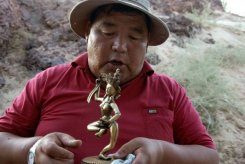August 2, 2009
London, UK — Boxes of rare Buddhist relics , not seen for more than 70 years, was unearthed in the Gobi Desert in Mongolia by a team of Mongolian and Austrian experts over the weekend, reports said Tusday.

The monastery was looted and destroyed by order of the mongolian government in 1937, but not before one monk named Tuduv hid many of the sacred objects.
Around 1,500 boxes of treasure had originally been stored at the monastery. Tuduv managed to bury 64 of them. The rest were destroyed.
Tuduv maintained the secret of the hidden crates for decades until finally revealing the story to his grandson Zundoi Altangerel.
When freedom of religion was allowed with the end of communism in 1990, Altangerel dug up a third of the boxes and placed his findings in a new museum.
Eisenriegler, an online media producer, visited the museum in 2008, met Altangerel, and learned that many more boxes still lay hidden in the Gobi.
Eisenriegler convinced the historian to dig up some of the boxes. That happened on Saturday with a joint team of Mongolian and Austrian experts on hand to inspect the items as they came out of the ground.
“My ancestors protected these boxes for many years. Now it is my duty to protect them,” said Altangerel to the AFP. “In the future we plan to dig up the remaining crates.”
The boxes housed a trove of artefacts including bronze statues, holy texts known as sutras and other riches, such as musical instruments, possibly used in Buddhist ceremonies at the monastery.
The crates also contained manuscripts. Historians are interested in studying the texts, hoping they will provide clues to daily life at Khamaryn Khiid.
“We were deeply impressed with this event…. These treasures were some of the most amazing things that I have seen, especially the statues,” Eisenriegler told to the BBC News Service after the dig.
The texts should also go a long way in helping historians better understand the founder of the monastery, Danzan Ravjaa, who lived from 1803 to 1856.
The legendary monk wrote hundreds of poems, performed Mongolias first opera and established schools and a museum. Wild legends about his miraculous feats still circulate among the Gobi nomads.
When Danzan Ravjaa died his mummified body was placed inside the White Temple of Khamaryn Khiid, and boxes of treasure were set around the body.
After hiding the boxes, the lama Tuduv escaped the carnage and became a herder. Over the decades he kept an eye on the boxes while preparing his grandson for the responsibility of taking care of the treasures.
The monastery reopened in 1991 and is now served by about 20 monks. It has become a popular pilgrimage destination for Mongolians seeking spiritual solace.
– Source :




